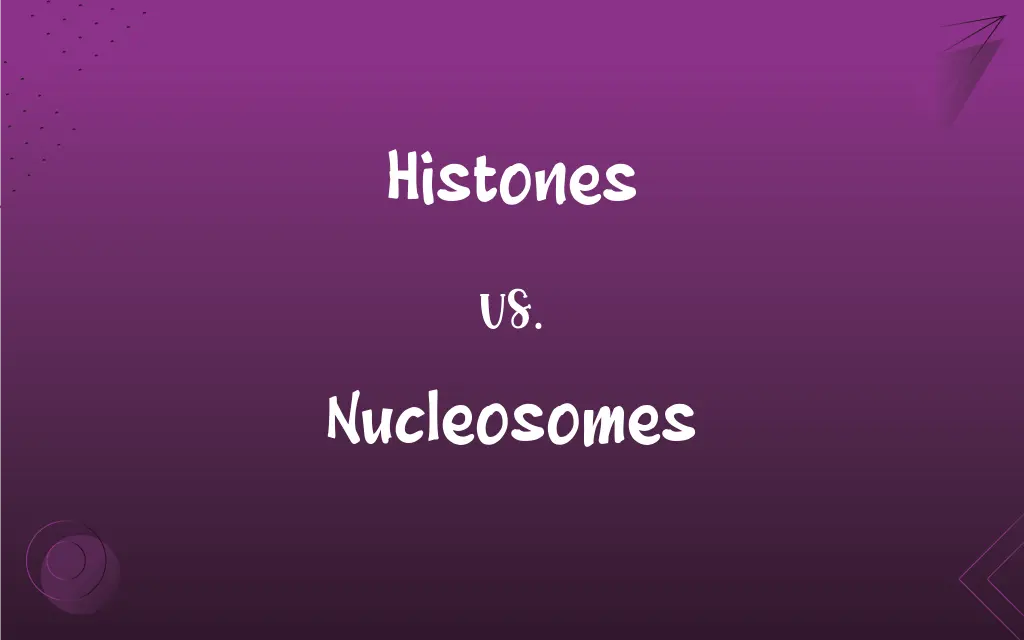Histones vs. Nucleosomes: What's the Difference?
Edited by Aimie Carlson || By Janet White || Published on March 10, 2024
Histones are proteins that package and order DNA into structural units. Nucleosomes are structural units of a chromosome, consisting of DNA wound around histones.

Key Differences
Histones are alkaline proteins found in eukaryotic cell nuclei that package and order DNA into structural units. They play a crucial role in gene regulation. Nucleosomes consist of DNA wrapped around histones, forming the basic unit of DNA packing in chromosomes. They are essential for compacting DNA into the nucleus.
In terms of structure, histones are composed of a core of eight proteins, around which DNA winds. This composition aids in the efficient packaging of DNA. Nucleosomes are formed when DNA wraps around this histone core approximately 1.65 times, aiding in the organization and regulation of DNA.
Functionally, histones can undergo various chemical modifications, affecting gene expression and DNA repair processes. These modifications include methylation and acetylation. Nucleosomes can be repositioned along DNA, influencing the accessibility of certain genes and thus playing a role in gene regulation.
The interaction between histones and DNA is not static. Histones can be modified, removed, or exchanged, impacting DNA processes. Nucleosomes can be disrupted or restructured during DNA replication and repair, highlighting their dynamic nature in chromosome structure and function.
Histones are the protein components that help structure and regulate DNA. They are fundamental to chromatin organization. Nucleosomes, comprising DNA and histones, represent the primary organizational unit of chromatin, crucial for DNA compaction and gene expression regulation.
ADVERTISEMENT
Comparison Chart
Definition
Proteins that package DNA
DNA and histone complexes forming chromosomal units
Composition
Core proteins
DNA wrapped around histone proteins
Function
Gene regulation via modifications
Compaction and organization of DNA
Role in Chromatin
Structural and regulatory proteins
Fundamental units of chromatin structure
Involvement in DNA Processes
Modified during gene expression and repair
Repositioned or restructured during replication and repair
ADVERTISEMENT
Histones and Nucleosomes Definitions
Histones
Proteins that structure DNA.
Histones play a vital role in the organization of genetic material.
Nucleosomes
Structural elements in chromosomes.
The arrangement of nucleosomes affects gene accessibility.
Histones
Alkaline proteins in eukaryotic cell nuclei.
Histones undergo modifications affecting gene expression.
Nucleosomes
Basic units of DNA packaging.
Nucleosomes help to compact long DNA molecules into the nucleus.
Histones
Regulators of DNA accessibility and repair.
The modification of histones can influence DNA transcription.
Nucleosomes
DNA segments wrapped around histone proteins.
Nucleosomes are fundamental to chromosome structure.
Histones
Components of chromatin structure.
Histones are crucial for DNA packaging within the nucleus.
Nucleosomes
Dynamic components of chromatin.
Nucleosomes reposition during DNA replication.
Histones
Elements in gene regulation.
Histones can be acetylated or methylated, impacting gene activity.
Nucleosomes
Key in regulating gene expression.
The positioning of nucleosomes can influence gene activation.
Histones
Any of several basic proteins found in association with the DNA in the chromatin of eukaryotes.
Nucleosomes
Any of the repeating subunits of chromatin found in eukaryotes, consisting of a DNA chain coiled around a core of histones.
Histones
Plural of histone
Nucleosomes
Plural of nucleosome
FAQs
How do histones affect DNA?
Histones organize and condense DNA, and their modifications can regulate gene expression.
What is a nucleosome?
A nucleosome is a structural unit of a chromosome, consisting of DNA wrapped around histone proteins.
What are histones?
Histones are proteins that help package and structure DNA in the nucleus.
What role do nucleosomes play in the cell?
Nucleosomes compact DNA into the nucleus and play a role in gene regulation.
How many histones are in a nucleosome?
A nucleosome core contains eight histone proteins.
Can histones be removed from DNA?
Yes, histones can be temporarily removed during processes like DNA replication and repair.
What is the significance of histone modifications?
Histone modifications can control gene activity and DNA repair processes.
Do histones bind directly to DNA?
Yes, histones bind directly to DNA, facilitating its packaging.
Are histones only found in eukaryotes?
Yes, histones are typically found in eukaryotic cells.
Can nucleosomes be found in prokaryotes?
No, nucleosomes are specific to eukaryotic chromatin structure.
Are nucleosomes static structures?
No, nucleosomes can be repositioned and modified, reflecting dynamic chromatin organization.
Are all histones identical?
No, there are different types of histones, each with specific roles.
Is the number of nucleosomes constant in a cell?
The number of nucleosomes varies depending on the cell type and stage of the cell cycle.
How does the nucleosome structure facilitate DNA compaction?
Nucleosomes compact DNA by allowing it to wind around histone proteins efficiently.
How do nucleosomes influence DNA repair?
Nucleosomes can be repositioned or altered to allow access to DNA repair machinery.
What is chromatin remodeling in relation to histones?
Chromatin remodeling involves the repositioning or modification of histones to change DNA accessibility.
How does nucleosome positioning affect genes?
Nucleosome positioning can influence the accessibility of DNA for transcription and replication.
What is the link between histones and gene expression?
Histones regulate gene expression through their modification and interaction with DNA.
What happens to nucleosomes during cell division?
During cell division, nucleosomes are duplicated and distributed to daughter cells.
Do histones play a role in diseases?
Yes, aberrant histone modification and function can be implicated in various diseases, including cancer.
About Author
Written by
Janet WhiteJanet White has been an esteemed writer and blogger for Difference Wiki. Holding a Master's degree in Science and Medical Journalism from the prestigious Boston University, she has consistently demonstrated her expertise and passion for her field. When she's not immersed in her work, Janet relishes her time exercising, delving into a good book, and cherishing moments with friends and family.
Edited by
Aimie CarlsonAimie Carlson, holding a master's degree in English literature, is a fervent English language enthusiast. She lends her writing talents to Difference Wiki, a prominent website that specializes in comparisons, offering readers insightful analyses that both captivate and inform.
































































